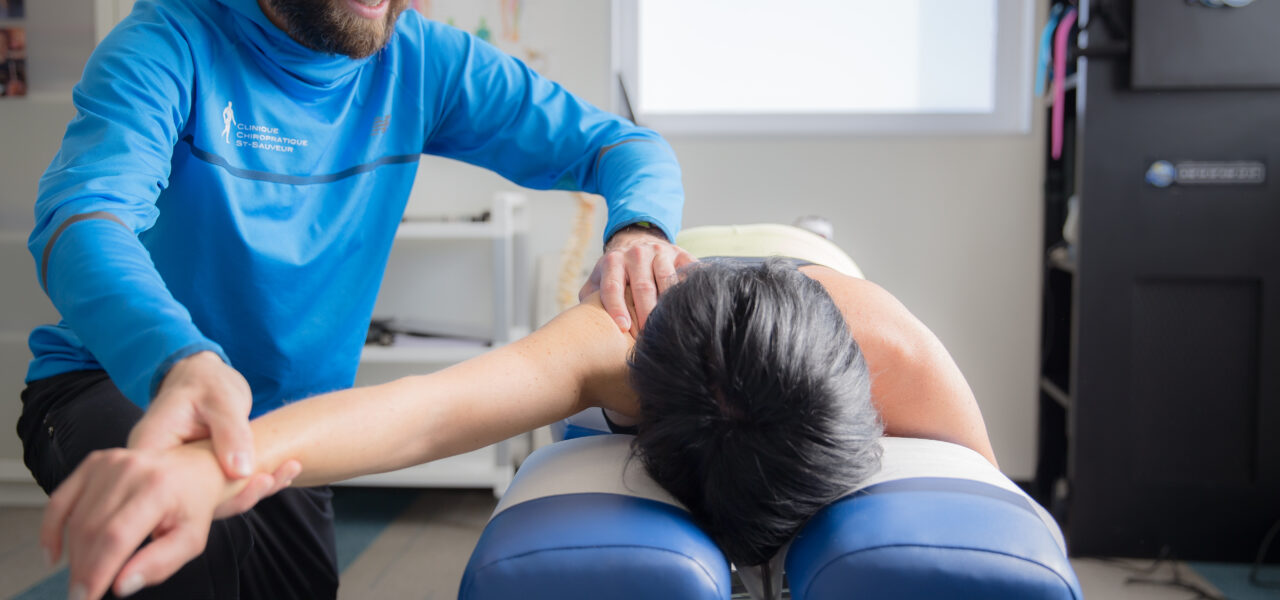Bursitis and tendinitis are among the most common neuromusculoskeletal conditions in the population. Workers who primarily use computers or perform repetitive movements are more at risk of developing these pathologies, and their incidence increases with age.
Bursitis
Bursae are small malleable sacs filled with synovial fluid (a lubricating liquid), which serves as a cushion between two musculoskeletal structures, for example, two tendons, a tendon and the skin, or a bone and another soft tissue (muscle, tendon, ligament and fascia). There are bursae on the shoulders, hips, knees, elbows, heels, etc. Bursitis occurs when bursae become irritated and inflamed.
The main causes of bursitis are:
- Direct injury to the bursae (ex: a fall, direct impact);
- Overuse of the affected area;
- Prolonged pressure on the bursae (ex: kneeling for a long time);
- Unusual exercise to the joint;
- Arthritis;
- Badly executed sport maneuver.
Bursitis starts with pain and swelling. This pain increases with movement and usually develops in the days following the injury.
The most common forms of bursitis are:
- Olecranon bursitis: located at the posterior tip of the elbow, it’s characterized by redness and swelling of the affected area;
- Subacromial or subdeltoid bursitis: Pain located on the top of the shoulder, movement is very limited;
- Prepatellar bursitis: located in front of the kneecap, the prepatellar bursa may become inflamed as a result of maintaining a kneeling or squatting position. It presents as redness and significant knee swelling.
Tendinitis
The tendon is a fibrous tissue that attaches the end of a muscle to the bone. It allows joint movement as a result of muscle contraction. Tendinitis is the inflammation of the tendon or the superficial layer that covers it (the sheath). It occurs as a result of an accumulation of micro-tears in the tendon.
The main causes of tendinitis are:
- Sudden muscle contraction;
- Poor work ergonomics;
- Muscle overuse (ex: overtraining);
- Poor biomechanics of the adjacent joint;
- Poor preparation or technique in a sport or activity
Tendinitis manifests as pain and decreased range of motion of the affected joint. Pain increases with muscle contraction and with active joint movement.
The most common forms of tendinitis are:
- Tennis elbow: a painful point on the lateral part of the elbow. Pain increases when taking objects and extending the wrist;
- Biceps tendonitis: Pain in the anterior part of the shoulder. It results from inflammation in the superficial layer that covers the biceps tendon;
- Rotator cuff tendinitis: Pain located at the upper and outer part of the shoulder;
- Frozen shoulder: Very severe shoulder pain accompanied by a considerable and gradual decrease in movement. This condition is also known as adhesive capsulitis and requires extensive therapy over prolonged periods of time before improvement.
Long-term side effects of bursitis and/or tendinitis
In the long term, the persistence or non-treatment of these conditions can lead to chronic pain, stiffness and even limitation of joint mobility. Finally, in the case of tendinitis, the tendon can break, requiring a long and difficult rehabilitation.
The chiropractic approach
As a result of training in chiropractic medicine, your chiropractor is able to diagnose if you have bursitis or tendinitis. They will be able to determine if your pain can be improved with a chiropractic treatment program or if you need to see another healthcare professional.
If the cause of your pain is neuromusculoskeletal, your chiropractor is able to help you. Through various manual therapy techniques, the chiropractic approach will aim to reduce pain and restore mobility to the affected joint. By tackling the bursitis or tendinitis problem globally, the chiropractor makes sure to reduce pain, restore the biomechanics of the affected area and prevent the recurrence of painful episodes. The chiropractor will also promote muscle relaxation by working on reducing tension and optimizing function of your muscles and soft tissues. Finally, your doctor in chiropractic medicine will be able to recommend the application of heat or cold and give advice such as when and how much to rest, what exercises to do and when it is safe to return to your favorite activity.

